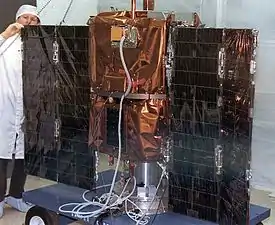Solar Anomalous and Magnetospheric Particle Explorer
The Solar Anomalous and Magnetospheric Particle Explorer (SAMPEX) was a NASA solar and magnetospheric observatory, and was the first spacecraft in the Small Explorer program. It was launched into low Earth orbit on July 3, 1992, from Vandenberg Air Force Base aboard a Scout G-1 rocket. SAMPEX was an international collaboration between NASA of the United States and the Max Planck Institute for Extraterrestrial Physics of Germany.[4]
 | |||||||||||
| Names | Explorer-68, SMEX-1 | ||||||||||
|---|---|---|---|---|---|---|---|---|---|---|---|
| Mission type | Magnetospheric research | ||||||||||
| Operator | NASA / GSFC Max Planck Institute | ||||||||||
| COSPAR ID | 1992-038A | ||||||||||
| SATCAT no. | 22012 | ||||||||||
| Website | http://lasp.colorado.edu/sampex/sampex.html | ||||||||||
| Mission duration | Planned: 3 years Final: 11 years, 11 months and 27 days[1] | ||||||||||
| Spacecraft properties | |||||||||||
| Manufacturer | NASA / GSFC | ||||||||||
| Launch mass | 157 kg (346 lb)[2] | ||||||||||
| Payload mass | 45.2 kg (100 lb)[2] | ||||||||||
| Dimensions | 1.5 × 0.9 m (4.9 × 3.0 ft) | ||||||||||
| Power | 102 W[2] | ||||||||||
| Start of mission | |||||||||||
| Launch date | July 3, 1992, 14:19 UTC[3] | ||||||||||
| Rocket | Scout G-1 | ||||||||||
| Launch site | Vandenberg SLC-5W | ||||||||||
| End of mission | |||||||||||
| Disposal | Reentered | ||||||||||
| Decay date | November 13, 2012, 11:42 UTC[2] | ||||||||||
| Orbital parameters | |||||||||||
| Reference system | Geocentric | ||||||||||
| Regime | Near-polar | ||||||||||
| Eccentricity | 0.009999999776482582 | ||||||||||
| Perigee altitude | 512 km (318 mi) | ||||||||||
| Apogee altitude | 687 km (427 mi) | ||||||||||
| Inclination | 81.7° | ||||||||||
| Period | 96.7 minutes | ||||||||||
| Epoch | July 3, 1992[3] | ||||||||||
| |||||||||||
The spacecraft carried four instruments designed to measure the anomalous components of cosmic rays, emissions from solar energetic particles, and electron counts in Earth's magnetosphere. Built for a three-year mission, its science mission was ended on June 30, 2004.[1] Mission control for SAMPEX was handled by the Goddard Space Flight Center until October 1997, after which it was turned over to the Bowie State University Satellite Operations Control Center (BSOCC).[2] BSOCC, with funding assistance from The Aerospace Corporation, continued to operate the spacecraft after its science mission ended, using the spacecraft as an educational tool for its students while continuing to release science data to the public.[5][6]
Built for a three-year primary mission, the spacecraft continued to return science data until its reentry on November 13, 2012.[5][7]
Instruments
Collaborators
SAMPEX collaborators included:[1]
- The Aerospace Corporation
- J. B. Blake, M. Looper, K. L. Lorentzen, D. Mabry, J. Mazur, R. Selesnick
- California Institute of Technology
- A. Cummings, R. Leske, R. Mewaldt, E. Stone
- Laboratory for Atmospheric and Space Physics, University of Colorado Boulder
- D. N. Baker, S. G. Kanekal, Xinlin Li
- Max Planck Institute, Garching
- D. Hovestadt, B. Klecker, M. Scholer
- NASA Goddard Space Flight Center
- T. Von Rosenvinge
- NASA Langley Research Center
- L. B. Callis, J. Lambeth
- University of Maryland, College Park
- G. M. Mason
- Washington University in St. Louis
- J. Cummings
References
- "SAMPEX Data Center". California Institute of Technology. Retrieved September 4, 2015.
- "SAMPEX". eoPortal. European Space Agency. Retrieved September 4, 2015.
- "SAMPEX - Trajectory Details". National Space Science Data Center. NASA. Retrieved September 4, 2015.
- Mason, G. M.; et al. (1998). SAMPEX: NASA's first small explorer satellite. IEEE Aerospace Conference. March 21–28, 1998. Aspen, Colorado. 5. pp. 389–412. Bibcode:1998aero....5..389M. doi:10.1109/AERO.1998.685848.
- "SAMPEX Mission Returns to Earth". The Aerospace Corporation. November 21, 2012. Retrieved September 4, 2015.
- Fox, Karen C. (November 1, 2012). "NASA's SAMPEX Mission: A Space Weather Warrior". NASA. Retrieved September 4, 2015.
- "Solar Anomalous and Magnetospheric Particle Explorer (SAMPEX)". The Aerospace Corporation. Retrieved September 4, 2015.
- "Heavy Ion Large Telescope (HILT)". National Space Science Data Center. NASA. Retrieved September 4, 2015.
- "Low-Energy Ion Composition Analyzer (LICA)". National Space Science Data Center. NASA. Retrieved September 4, 2015.
- "Mass Spectrometer Telescope (MAST)". National Space Science Data Center. NASA. Retrieved September 4, 2015.
- "Proton-Electron Telescope (PET)". National Space Science Data Center. NASA. Retrieved September 4, 2015.
Further reading
- Baker, Daniel N.; et al. (May 1993). "An overview of the Solar, Anomalous, and Magnetospheric Particle Explorer (SAMPEX) mission". IEEE Transactions on Geoscience and Remote Sensing. 31 (3): 531–541. Bibcode:1993ITGRS..31..531B. doi:10.1109/36.225519.
External links
- SAMPEX website by the University of Colorado Boulder
- SAMPEX Data Center by the California Institute of Technology
- SAMPEX archived website by the Goddard Space Flight Center
.png.webp)